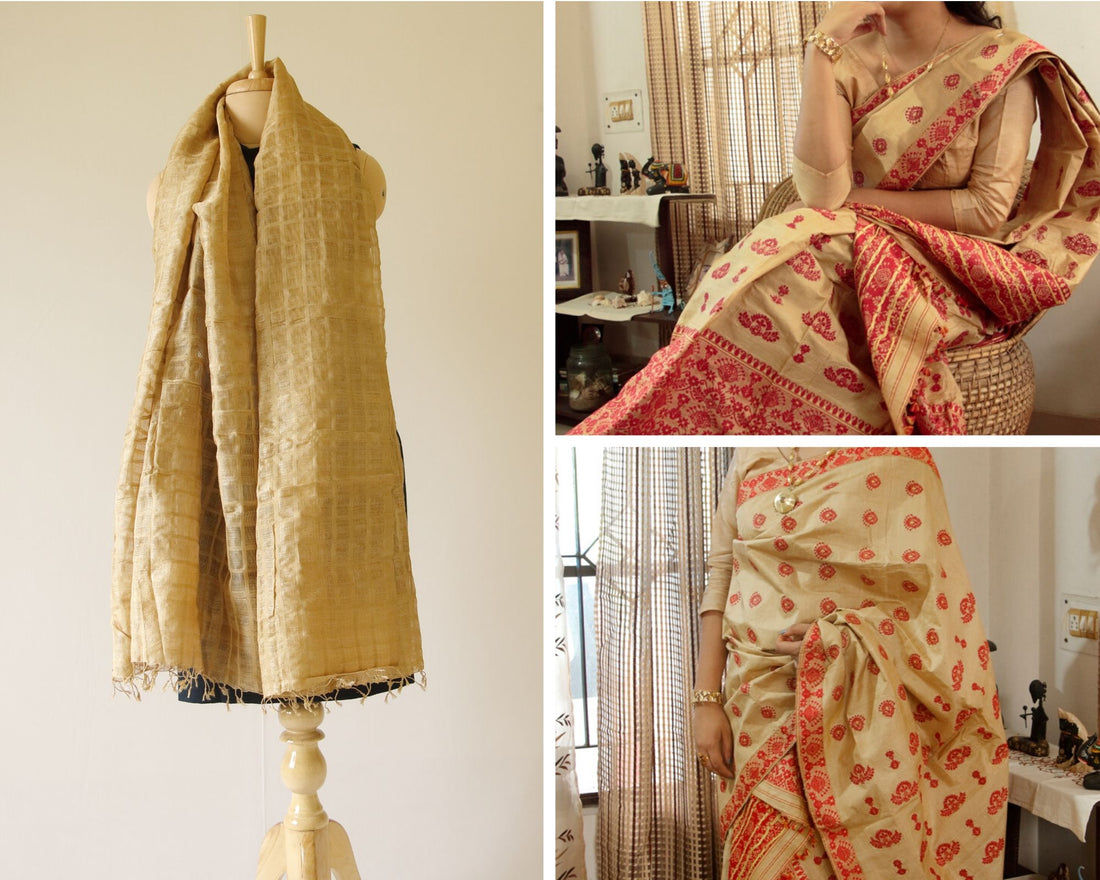
Muga Silk - Know more about this rare silk.
Share

The textile traditions of India has played a important role in the Arts & Culture of India. It is true for all parts of India , including the North Eastern states , particularly Assam . Muga Silk from Assam is very special because of its rarity and exclusiveness and because of its role in the culture of Assam.
The North Eastern States of India are Assam , Meghalaya , Arunachal Pradesh , Manipur , Nagaland , Mizoram , Tripura and we can also say Sikkim. The region has a rich heritage of artistic handloom products that has been shaped through centuries by the various indigenous groups of people as well as different ethnic populations that migrated to this region.
The focus of this article is the Muga Silk of Assam .
Assam is one of the few states in India that produces all the four commercial varieties of Silk . They are Mulberry , Tassar , Muga and Eri .
Muga , Tassar and Eri are also listed as Vanya Silk or Wild Silks by the silk board of India.
Of all the four varieties , Muga Silk and Eri Silk can be truly termed as Assam Silks . They are considered to be of indigenous origin and found only in Assam and the foothills of Meghalaya . Of these two , Assam produces almost 95 % of Muga productions in India .The moth is indigenous to the Brahmaputra Valley. In fact it will be correct to say that Assam breeds and produces almost all of the Muga silk moth in the world .
It also happens to be the rarest silk from India , for that matter one of the rarest in the world. That makes it very expensive.
A bit of its History
The knowledge of wild silk have been in the Indian Subcontinent since ancient times. Fragments of Silk fibres have been found in Harappa , Mohenjo-Daro and Chandu-Daro towns of the Indus Valley Civilization dating back 2400-2500 BCE. The silk appear to be either that of the Tasar silk moth or Muga silk moth. There is evidence of silk being used over a wide region of the Indian Subcontinent about 2000 years before the more common mulberry based silk from China arrived around 2nd century CE.
Silk is mentioned in the Ayurveda . The Vedas were composed between 1500 - 600 BCE. Silk has been mentioned in the famous Hindu epics of Mahabharata and Ramayana .
The Muga silk moth is mentioned in literature as early as 1662 BCE. The Chinese envoy and explorer Zhang Qian reports on the silk trade between Assam and China around 100 BCE. The Muga silk fabrics were greatly admired as far as Chengdu in the east and other northern Chinese towns.
Recent reference is found in the Kalika Purana from around 900 C.E .
Patronage
Later , the Ahoms who were an offshoot of the Tai or Shan race of the Mongoloid group came to Assam in the early thirteenth century. Over the period of time, they established their kingdom over whole of the Assam Valley and ruled over it for close to 600 years. It is under their patronage that the craft of handloom weaving and seri culture flourished and developed. They established a department of weaving and maintained skilled weavers under them. They provided grants of rent free lands and other favours in return for their services. It is under them that the traditional dress of the Assamese woman began to be made from Muga Silk and Pat Silk ( mulberry Silk ). Silk or its garments during their reign was restricted to only the royal family .
Muga Silk Moth
The Muga silk moth's scientific name is Antheraea assamensis . As you can see the name of Assam is mentioned in the scientific name itself. Its natural habitats are the deep forests of the sub mountainous area of Assam and surroundings and the north eastern parts of West -Bengal.
The larvae feeds mostly on the leaves of the Som tree ( Persea bombycina ) in Upper Assam and the Sualu tree ( Litsea monopetala ) in Lower Assam.
The larvae that feeds on Som tree yields more silk and lays more eggs than the larvae that feeds on the Sualu tree.

The moth produces a rich golden yellow or light brown colour yarn depending upon on the host plant leaves and the season.
Muga Silk Culture
The breeding and collecting of the silk moths is still a very village led affair . It is still the privilege of some particular tribes to collect them.
Most of the cocoons are purchased by the traders of Sualkuchi ( a weaving town near Guwahati , Assam ) where the commercial reeling and weaving part is done.
There is still a culture of hand reeling but at a very small scale. Hand reeled silks will be more expensive than the machine reeled silks .
Muga Silk Properties

Muga Silk is a very unique product . The natural golden sheen is found in no other silk . Tassar silk does have the golden sheen but not like Muga and is also stronger than Tassar .
Secondly, it resists sunshine better and is more durable than mulberry silk. . Muga can outlast your lifetime. Wild silks tend to be more coarse and less compact than mulberry silk. Hence the characteristics of the end product will be different than mulberry.
Muga silk fabrics are not as supple, smooth or flowy as mulberry silk fabrics.
Silks - how is silk made, properties and more - click here
Muga silk is also listed under the GI or Geogrophical Indicator list of India
Where to buy Assam Silk
Assam is a state that has one of the highest number of handlooms. So , silks are widely available across the State . From small retailer to boutiques to brands, you will find authentic silk in every town in Assam .
One of the established brand that you can check out is The Silkalay . They have branches everywhere.
If you are outside Assam , you can check out the govt sponsored fairs in your city to find genuine silks like the North East Festival in Delhi or you can check out Dilli Haat .
What you have to keep in mind while buying Muga silk .

Silk is expensive. Very expensive !! like all other fabrics the final cost depends upon the weave, texture, value additions like embroidery or print , the dye etc. But most importantly it will depend on the rarity of the silk , the yarn count (i.e fineness of the yarn ), and fabric count . All silks are rare . And it is a very difficult and labour intensive process that results in very low final yield. But Some silks are rarer than others. Muga is one of those.
Beware of any product that is being sold cheaply. Generally a Muga Sari will start at around INR 35000 /- Appx . Current Market rate.
You may come across terms like Spun Muga .
So What is Spun Muga ?
Spun Silk is silk obtained from ruptured cocoons. For instance , Eri Silk ( another indigenous Assam Silk ) is always spun silk as it is obtained from pierced cocoons . In case of Muga Silk , all Muga silk is not Spun Silk but some are. The Muga Spun is a weaker fibre than the reeled yarns and also has a coarser hand feel and no sheen .

Beware of bright coloured fabrics being sold off as Muga silk. Many established online retailers are doing that. Muga's USP is its golden sheen . Plus unlike mulberry , it is not too keen to be dyed ., i.e does not dye easily. So those products are just not Muga Silk !!
In Assam, i do not know of any weaver or Muga silk product produced in any other colour than in its natural colour.
The yarn itself is too expensive and over all production is too low for it to be made into some fancy running yardages that you see online selling at INR 1400 /- or 1200 /- @ mtr. Maybe they are using Muga for the motif on the body or so but definitely at that price , the whole material is not silk.
And most importantly
It is not Mulberry Silk !!
Because of its inherent characteristics , the final fabric will never have the softness , smoothness , shine or drape associated with the more common mulberry .. This is true for all wild silks like Tassar or Eri . But Tassar and Eri still have more softness and fluidity than Muga.
So - do not get fooled !!
Buy from authentic sources - Look for the Silk Mark Tag.
If you want to know more in detail about Muga silk , you can get the following books .
Textile Tradition of Assam by Labanya Mazumdar available at Fabric Plus Pvt Ltd.
Indian Ways of Silk by Ole Zethner, Rie Koustrup , Dilip Barooah available at Fabric Plus Pvt Ltd.
You can also check my other silk related posts .
What is Assam silk - Click here to know more about the other silks from this State .
What are the different varieties of Silk Fabrics - know more
Banarasi silks , Baluchari Silks and more
Kanchivarams , Chanderi , Maheshwari Silks and more
